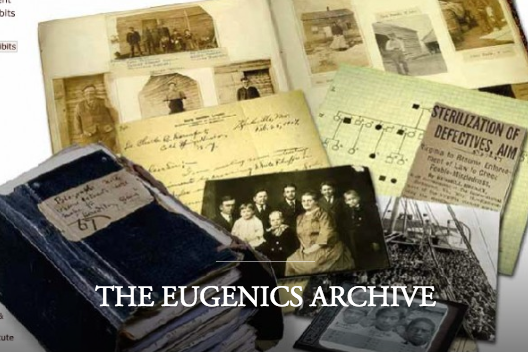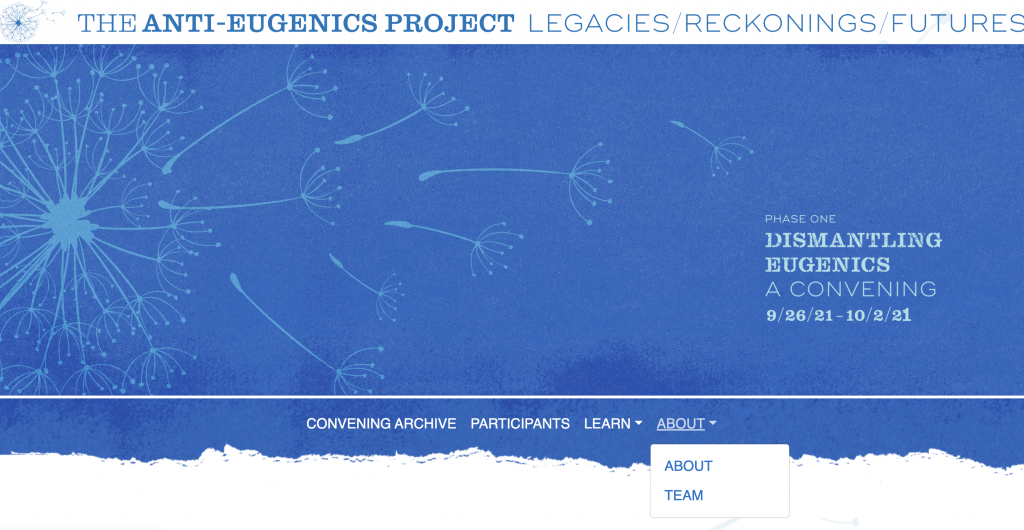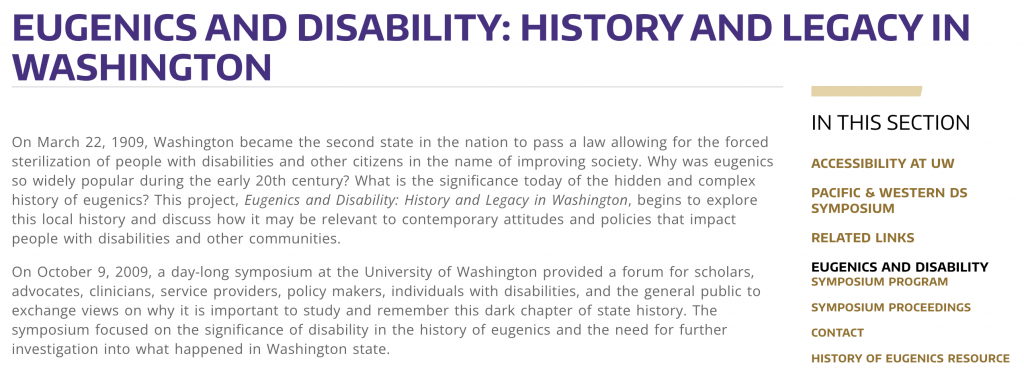Resources
SCHOLARSHIP ON THE HISTORY OF EUGENICS
For more than a generation, scholars of the history of science have documented and debated the history of the American eugenics movement. Recently, universities and museums are examining their own roles in the eugenics movement by opening up their archives (for an example, click HERE). Here is a (non-exhaustive) list of some of the most important scholarship on the topic:
Allen, Garland E. “The Eugenics Record Office at Cold Spring Harbor, 1910-1940: An Essay in Institutional History.” Osiris 2(1986): 225–64.
Brave, Ralph, and Kathryn Silva. “Exhibiting Eugenics: Response and Resistance to a Hidden History.” The Public Historian 29(2007): 33–51.
Burke, Chloe S., and Christopher J. Castenada. “The Public and Private History of Eugenics: An Introduction.” The Public Historian 29(2007): 5–17.
Comfort, Nathaniel. “‘Polyhybrid heterogeneous bastards’: promoting medical genetics in America in the 1930s and 1940s.” Journal of the history of medicine and allied sciences 61(2006): 415- 455.
____. The Science of Human Perfection: How Genes Became the Heart of American Medicine. Yale University Press, 2012.
____. “A new eugenics.” Nation 301(2015): 27-32.
Cot, Annie L. “‘Breed out the Unfit and Breed in the Fit’: Irving Fisher, Economics, and the Science of Heredity.” The American Journal of Economics and Sociology 64(2005): 793–826.
Dorr, Gregory Michael. “Assuring America’s place in the sun: Ivey Foreman Lewis and the teaching of eugenics at the University of Virginia, 1915-1953.” The Journal of Southern History 66(2000): 257-296.
Dyck, Erika. “Sterilization and Birth Control in the Shadow of Eugenics: Married, Middle-Class Women in Alberta, 1930–1960s.” Canadian Bulletin of Medical History 31(2014): 165- 187.
Dyck, Erika and Maureen Lux. “Population Control in the ‘Global North’?: Canada’s Response to Indigenous Reproductive Rights and Neo-Eugenics.” Canadian Historical Review 97(2016): 481-512.
Glenna, Leland L., Margaret A. Gollnich and Stephen S. Jones. “Eugenic Opportunity Structures: Teaching Genetic Engineering at US Land-Grant Universities since 1911,” Social Studies of Science 37(2007): 281-296.
Kevles, Daniel J. In the Name of Eugenics: Genetics and the Uses of Human Heredity. No. 95. Harvard University Press, 1995.
Kimmelman, Barbara A. “The American Breeders’ Association: Genetics and Eugenics in an Agricultural Context, 1903-13.” Social Studies of Science 13(1983): 163–204.
Ladd-Taylor, Molly. “Saving babies and sterilizing mothers: Eugenics and welfare politics in the interwar United States.” Social Politics: International Studies in Gender, State & Society 4(1997): 136-153.
____. “Eugenics, sterilisation and modern marriage in the USA: The strange career of Paul Popenoe.” Gender & History 13(2001): 298-327.
___. Fixing the Poor: Eugenic Sterilization and Child Welfare in the Twentieth Century. Johns Hopkins, 2017.
Largent, Mark A. Breeding Contempt: The History of Coerced Sterilization in the United States. Rutgers University Press, 2011.
Larson, Edward J. Sex, Race, and Science: Eugenics in the Deep South. Baltimore: Johns Hopkins University Press, 1995.
Lombardo, Paul A., and Gregory M. Dorr. “Eugenics, Medical Education, and the Public Health Service: Another Perspective on the Tuskegee Syphilis Experiment,” Bulletin of the History of Medicine 80(2006): 291-316.
____., ed. A century of eugenics in America: from the Indiana experiment to the human genome era. Indiana University Press, 2011.
Lovett, Laura L. “‘Fitter Families for Future Firesides’: Florence Sherbon and Popular Eugenics.” The Public Historian 29(2007): 69–85.
Nurridin, Ayah. “The Black Politics of Eugenics,” Nursing Clio. June 1, 2017.
Ordover, Nancy. American Eugenics: Race, Queer Anatomy, and the Science of Nationalism. University of Minnesota Press, 2003.
Paul, Diane. “Eugenics and the Left.” Journal of the History of Ideas 45(1984): 567–90.
____. The Politics of Heredity: Essays on Eugenics, Biomedicine, and the Nature-Nurture Debate. SUNY Press, 1998.
____. Controlling Human Heredity: 1865 to the Present. Humanities Books, 1995.
____. “From eugenics to medical genetics.” Journal of Policy History 9(1997): 96-116.
____. “What was wrong with eugenics? Conflicting narratives and disputed interpretations.” Science & Education 23(2014): 259-271.
____. “Reflections on the historiography of American eugenics: Trends, fractures, tensions.” Journal of the History of Biology 49 (2016): 641-658.
Paul, Diane, Hamish G. Spencer and John Stenhouse, eds., Eugenics at the Edges of Empire. Palgrave Macmillan, 2017.
Pauly, Philip J. Biologists and the Promise of American Life: from Meriwether Lewis to Alfred Kinsey. Princeton University Press, 2002.
Platt, Tony. “Engaging the Past: Charles M. Goethe, American Eugenics, and Sacramento State University.” Social Justice 32, no. 2 (100 (2005): 17-33.
Rembis, Michael. “Disability and the History of Eugenics,” The Oxford Handbook of Disability History (2018): 85-103.
____. “(Re)Defining Disability in the ‘Genetic Age’: Behavioral Genetics, ‘New Eugenics,’ and the future of impairment,” Disability & Society 24(2009): 585-597.
Roberts, Dorothy. Killing the Black Body: Race, Reproduction, and the Meaning of Liberty. Vintage, 2014.
Rosen, Christine. Preaching eugenics: Religious leaders and the American eugenics movement. Oxford University Press, 2004.
Rutecki, Gregory W. “Forced sterilization of native Americans: Later twentieth century physician cooperation with national eugenic policies?.” Ethics & Medicine 27, no. 1 (2011): 33-42.
Stepan, Nancy Leys. The Hour of Eugenics: Race, Gender, and Nation in Latin America. Cornell University Press, 1998.
Stern, Alexandra Minna. “Sterilized in the name of public health: race, immigration, and reproductive control in modern California.” American Journal of Public Health 95(2005): 1128- 1138.
____. Eugenic nation: Faults and frontiers of better breeding in modern America. Vol. 17. Univ of California Press.Woiak, Joanne. 2007. “Designing a brave new world: Eugenics, politics, and fiction.” The Public Historian 29(2016): 105-129.
Washington, Harriet. The Dark History of Medical Experimentation on Black Americans from Colonial Times to the Present. Doubleday, 2006.
Wellerstein, Alex. “States of Eugenics: Institutions and Practices of Compulsory Sterilization in Canada,” in Reframing Rights: Bioconstitutionalism in the Genetic Age, edited by Sheila Jasanoff (Cambridge, MA: MIT Press, 2011), 29-58.





